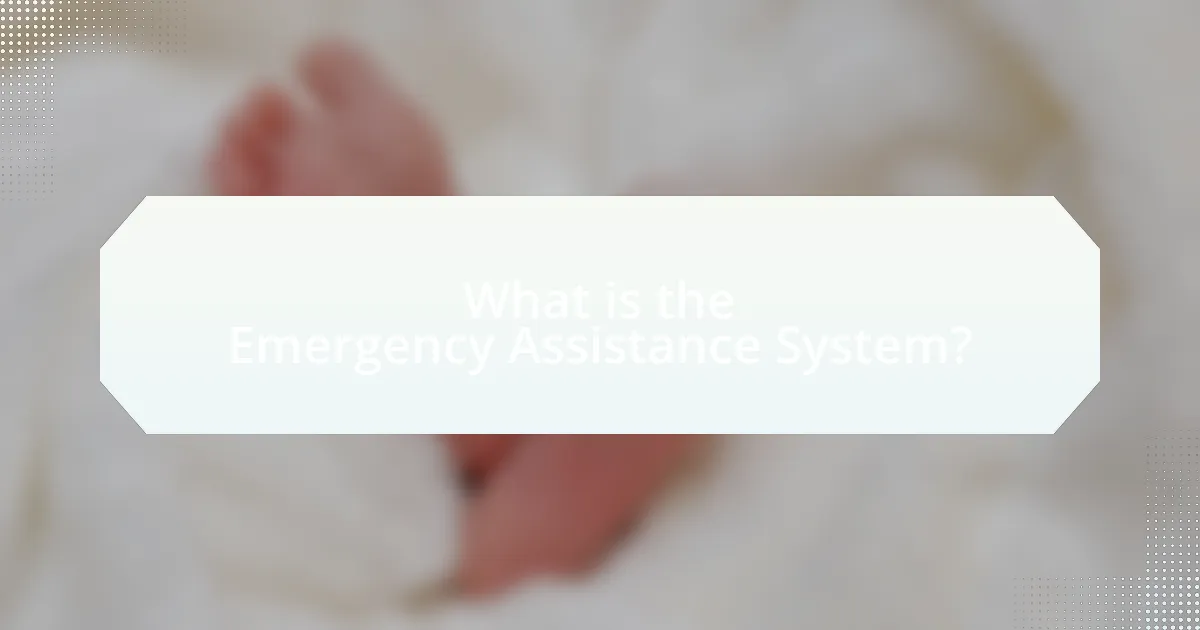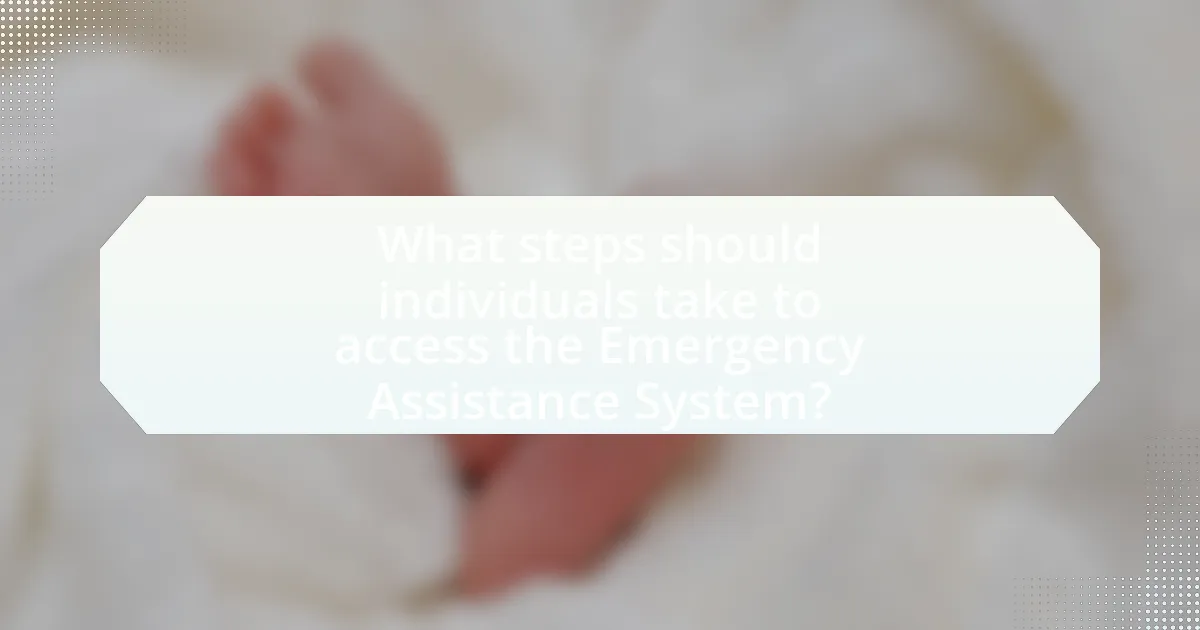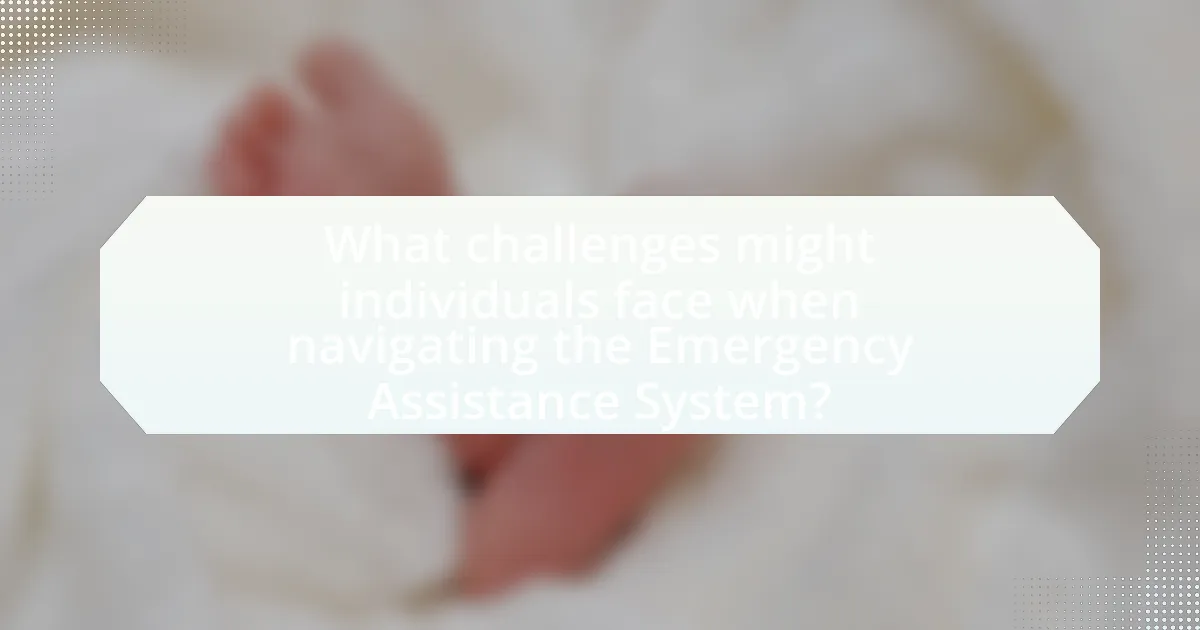The Emergency Assistance System is a structured framework designed to provide immediate support to individuals facing crises such as natural disasters, financial hardships, or medical emergencies. This article outlines the system’s key components, including crisis intervention services, financial aid, food assistance, housing support, and healthcare access, while detailing how these elements interact during emergencies. It also highlights the demographics most likely to benefit from this system, the steps individuals should take to access assistance, and the common challenges they may encounter. Additionally, the article provides guidance on how to navigate the application process effectively and stay informed about available resources and updates within the Emergency Assistance System.

What is the Emergency Assistance System?
The Emergency Assistance System is a framework designed to provide immediate support and resources to individuals facing crises, such as natural disasters, financial hardships, or medical emergencies. This system typically includes various services such as food assistance, shelter, medical care, and financial aid, aimed at alleviating urgent needs. For instance, organizations like the Federal Emergency Management Agency (FEMA) in the United States coordinate disaster relief efforts, demonstrating the system’s role in mobilizing resources quickly to assist affected populations.
How does the Emergency Assistance System function?
The Emergency Assistance System functions by providing immediate support and resources to individuals facing crises, such as natural disasters, medical emergencies, or financial hardships. This system typically operates through a network of government agencies, non-profit organizations, and community resources that coordinate to assess needs and deliver aid. For instance, during a natural disaster, local emergency management agencies activate the system to deploy shelters, food, and medical assistance, ensuring that affected individuals receive timely help. The effectiveness of this system is evidenced by its structured response protocols, which have been developed and refined through historical events, demonstrating its capacity to mobilize resources efficiently in times of need.
What are the key components of the Emergency Assistance System?
The key components of the Emergency Assistance System include crisis intervention services, financial assistance programs, food and nutrition support, housing assistance, and access to healthcare services. Crisis intervention services provide immediate support and resources to individuals facing emergencies. Financial assistance programs offer monetary aid for essential needs such as utilities and rent. Food and nutrition support ensures access to food through food banks and meal programs. Housing assistance helps individuals secure stable living conditions, while access to healthcare services addresses medical needs during emergencies. These components work together to provide comprehensive support to individuals in crisis situations.
How do these components interact during an emergency?
During an emergency, the components of the emergency assistance system interact through a coordinated response involving communication, resource allocation, and support services. Emergency responders, such as police, fire, and medical personnel, communicate with each other and with dispatch centers to assess the situation and deploy necessary resources effectively. This interaction ensures that critical services are provided promptly, as evidenced by the National Fire Protection Association’s report indicating that effective communication can reduce response times by up to 30%. Additionally, community organizations and government agencies collaborate to offer support services, such as shelter and food, ensuring that individuals affected by the emergency receive comprehensive assistance. This collaborative approach is essential for managing the complexities of emergencies and ensuring that all components work together efficiently.
Who can benefit from the Emergency Assistance System?
Individuals and families facing financial hardship can benefit from the Emergency Assistance System. This system is designed to provide immediate support to those experiencing crises such as job loss, medical emergencies, or natural disasters. According to the U.S. Department of Health and Human Services, emergency assistance programs aim to alleviate the impact of unforeseen circumstances by offering financial aid, food assistance, and housing support, thereby helping vulnerable populations regain stability.
What demographics are most likely to need assistance?
Low-income individuals, single-parent households, the elderly, and people with disabilities are demographics most likely to need assistance. According to the U.S. Census Bureau, approximately 11.8% of the population lives below the poverty line, which significantly increases the likelihood of requiring emergency assistance. Additionally, single-parent households, which make up about 27% of families with children, often face financial challenges that necessitate support. The elderly, particularly those aged 65 and older, represent a growing segment of the population that may require assistance due to fixed incomes and health-related issues. Furthermore, individuals with disabilities, who account for about 12.6% of the population, frequently encounter barriers that make accessing resources more difficult, thereby increasing their need for assistance.
How does the system cater to different needs?
The system caters to different needs by offering a variety of tailored services and resources designed to address specific circumstances of individuals in crisis. For instance, it provides financial assistance, food support, housing resources, and mental health services, ensuring that diverse populations, including families, the elderly, and individuals with disabilities, receive appropriate help. Data from the U.S. Department of Health and Human Services indicates that such targeted assistance improves outcomes for those in need, as it allows for a more personalized approach to emergency support.

What steps should individuals take to access the Emergency Assistance System?
To access the Emergency Assistance System, individuals should first identify their eligibility based on specific criteria set by local or state agencies. Next, they must gather necessary documentation, such as identification, proof of income, and any relevant bills or notices. After preparing the required documents, individuals should contact their local emergency assistance office or visit their website to initiate the application process. Finally, they need to submit their application and follow up to ensure it is being processed. These steps are essential for effectively navigating the Emergency Assistance System and securing the needed support.
How can one identify the appropriate resources available?
To identify the appropriate resources available, one should conduct a thorough assessment of their specific needs and circumstances. This involves researching local organizations, government programs, and community services that offer assistance relevant to those needs. For instance, the U.S. Department of Health and Human Services provides a comprehensive directory of resources, including food assistance, housing support, and healthcare services, which can be accessed through their website. Additionally, utilizing 2-1-1 services can connect individuals to local resources tailored to their situation, ensuring they receive the most suitable assistance.
What types of assistance are typically offered?
Emergency assistance systems typically offer financial aid, food assistance, housing support, medical care, and counseling services. Financial aid helps individuals cover essential expenses such as rent or utilities, while food assistance programs provide access to groceries or meals. Housing support includes temporary shelters or long-term housing solutions, and medical care may involve free or low-cost clinics. Counseling services offer emotional support and guidance during crises. These types of assistance are designed to address immediate needs and help individuals regain stability.
How can individuals find local assistance programs?
Individuals can find local assistance programs by utilizing online resources, contacting local government offices, and reaching out to community organizations. Online platforms such as 211.org provide comprehensive directories of assistance programs based on geographic location. Local government offices, including social services departments, often have information on available resources. Additionally, community organizations, such as food banks and non-profits, frequently offer assistance and can guide individuals to relevant programs in their area.
What documentation is required to apply for assistance?
To apply for assistance, individuals typically need to provide proof of identity, proof of income, and documentation of their current living situation. Proof of identity may include a government-issued ID or social security card, while proof of income can be demonstrated through pay stubs, tax returns, or benefit statements. Documentation of the current living situation often requires a lease agreement, utility bills, or other official correspondence that verifies residency. These requirements ensure that the assistance program can accurately assess eligibility and need.
What information should applicants prepare in advance?
Applicants should prepare personal identification information, proof of income, and details about their household situation in advance. Personal identification includes government-issued IDs, Social Security numbers, and birth certificates for all household members. Proof of income can consist of recent pay stubs, tax returns, or benefit statements. Additionally, applicants should gather information about their housing situation, such as lease agreements or mortgage statements, and any relevant medical or educational documents that may support their case for assistance. This preparation ensures a smoother application process and increases the likelihood of receiving the necessary support.
How can applicants ensure their documentation is complete?
Applicants can ensure their documentation is complete by carefully reviewing the specific requirements outlined by the emergency assistance program they are applying to. This includes checking for necessary forms, identification, proof of income, and any additional documentation specified in the application guidelines. According to the U.S. Department of Health and Human Services, incomplete applications can lead to delays or denials, emphasizing the importance of thoroughness in documentation.

What challenges might individuals face when navigating the Emergency Assistance System?
Individuals may face several challenges when navigating the Emergency Assistance System, including complex eligibility requirements, limited availability of resources, and bureaucratic delays. The complexity of eligibility criteria can lead to confusion, as individuals may struggle to understand what documentation is necessary to qualify for assistance. Additionally, resources such as financial aid or housing support may be limited, resulting in long wait times or insufficient aid for those in need. Bureaucratic delays can further complicate the process, as individuals may encounter slow response times or difficulties in communication with service providers, which can hinder timely access to necessary support.
What common obstacles do applicants encounter?
Applicants commonly encounter obstacles such as complex application processes, lack of clear information, and eligibility confusion. The complexity of the application process often leads to frustration, as many applicants struggle to understand the required documentation and steps needed to complete their applications. Additionally, the lack of clear and accessible information about available resources can hinder applicants from making informed decisions. Furthermore, confusion regarding eligibility criteria can result in applicants feeling discouraged, as they may not know if they qualify for assistance programs. These challenges are frequently reported in studies examining the experiences of individuals seeking emergency assistance, highlighting the need for improved support systems.
How can individuals overcome these obstacles?
Individuals can overcome obstacles in navigating the emergency assistance system by actively seeking information and utilizing available resources. Engaging with local community organizations, government agencies, and online platforms can provide essential guidance and support. For instance, studies show that individuals who connect with local nonprofits often receive tailored assistance that addresses their specific needs, improving their chances of successfully accessing emergency aid. Additionally, participating in workshops or informational sessions can enhance understanding of the application processes and eligibility requirements, further empowering individuals to navigate the system effectively.
What resources are available for additional support?
Various resources are available for additional support in navigating the emergency assistance system. These include local government agencies that provide financial aid, food assistance programs, and housing support services. Nonprofit organizations, such as the Salvation Army and United Way, offer emergency relief services and can connect individuals with necessary resources. Additionally, community hotlines and online platforms provide information on available assistance programs and eligibility criteria. According to the U.S. Department of Health and Human Services, over 30% of individuals seeking assistance utilize these community resources effectively.
How can individuals stay informed about changes in the Emergency Assistance System?
Individuals can stay informed about changes in the Emergency Assistance System by regularly checking official government websites and subscribing to updates from relevant agencies. These websites often provide timely information on policy changes, eligibility criteria, and available resources. Additionally, following social media accounts of these agencies can offer real-time updates and announcements. Engaging with local community organizations that assist with emergency assistance can also provide insights and notifications about changes in the system.
What channels provide updates on assistance programs?
Government websites, social media platforms, and local community organizations provide updates on assistance programs. Government websites, such as those of the Department of Health and Human Services or local state agencies, regularly post information about available assistance programs and eligibility criteria. Social media platforms, including Facebook and Twitter, are used by many organizations to disseminate real-time updates and announcements regarding assistance programs. Additionally, local community organizations often share information through newsletters, community boards, and outreach events, ensuring that individuals in need are informed about available resources.
How can individuals engage with community resources for ongoing support?
Individuals can engage with community resources for ongoing support by actively seeking out local organizations, services, and programs that address their specific needs. This can include visiting community centers, contacting non-profit organizations, or utilizing online directories that list available resources. Research indicates that individuals who connect with local support networks, such as food banks, mental health services, and housing assistance programs, experience improved outcomes in their situations. For example, a study by the Urban Institute found that access to community resources significantly enhances individuals’ ability to cope with crises and improve their overall well-being.
What best practices should individuals follow when seeking emergency assistance?
Individuals seeking emergency assistance should clearly identify their situation and communicate their needs effectively. This involves providing essential information such as location, nature of the emergency, and any immediate threats to safety. Research indicates that clear communication can significantly reduce response times and improve outcomes in emergencies. For instance, the National Emergency Number Association emphasizes the importance of concise and accurate information when contacting emergency services, as it aids in the swift allocation of resources.
How can applicants prepare for potential interviews or assessments?
Applicants can prepare for potential interviews or assessments by researching the organization and understanding the specific requirements of the emergency assistance program. Familiarizing themselves with common interview questions and practicing responses can enhance their confidence and performance. Additionally, reviewing relevant documentation and eligibility criteria ensures that applicants can provide accurate information during the assessment. Studies show that preparation significantly increases the likelihood of success in interviews, as candidates who practice and understand the context are often viewed more favorably by interviewers.
What tips can help streamline the application process?
To streamline the application process for emergency assistance, applicants should gather all necessary documentation beforehand, including identification, proof of income, and any relevant bills. This preparation reduces delays and ensures that all required information is submitted at once, which can expedite processing times. Research indicates that organized submissions can decrease application processing time by up to 30%, as noted in studies by the National Association of Social Workers.

Leave a Reply